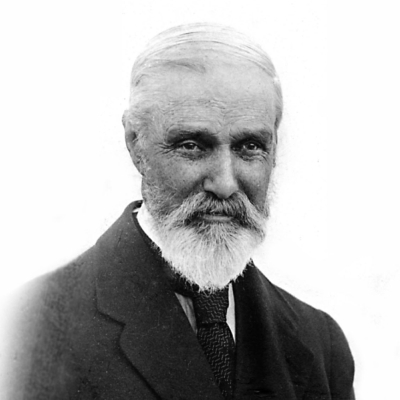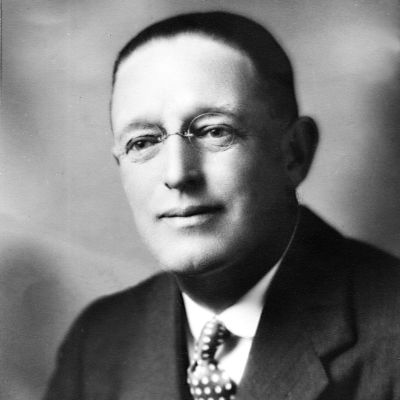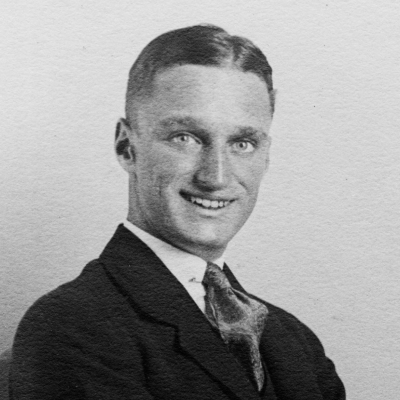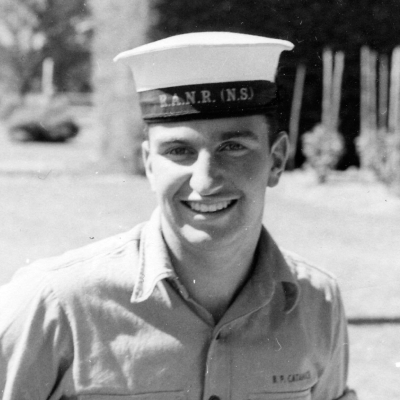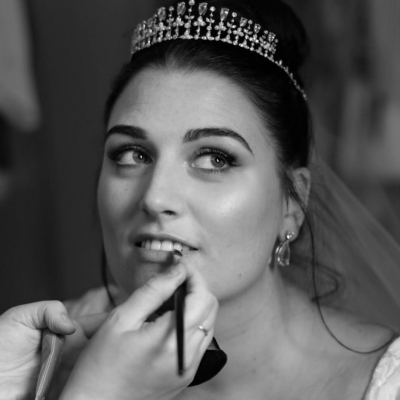Alan Catanach
Amidst a post-WWII economic revival, William Alan Catanach played a
pivotal role in Catanach's Jewellers journey. Discover William, or Bill,
and his appreciation for gemstones, leadership in the jewellery
industry, and dedication to philanthropy, which created a legacy both
personally and professionally. This was a time when Melbourne was
hosting world events — and the introduction of television meant it was
being showcased globally. Explore the Catanach’s evolution through
this period, along with national milestones from the birth of the iconic
Holden to Australia's pioneering aviation invention.
In this chapter, we also introduce you to the inspiration behind a
special project we have been working on behind the scenes based
on the hydrangea: our 150-Year Anniversary Botanical Series.

Gemstone aficionado
and family man
By the time of his father William Mercer's
death in 1947, William Alan Catanach
(better known as Bill) had made a name
for himself in the family's business,
earning recognition for his passion for
gemstones. Though he never completed
formal training as a jeweller, his self-taught
knowledge in gemmology led his
peers to regard him as highly skilled in
the jewellery trade. Having married the
love of his life Corona Shepherd in a
widely celebrated society wedding,
Bill was also a proud father of Blair
and Julia.
Contribution to the
jewellery industry
Bill’s career saw him contribute
significantly to the jewellery industry,
and he was deeply involved in industry
organisations. So much so, that in 1947
his passion for gemmology led to the
establishment of the Victorian branch of
the Gemmological Association of
Australia (GAA). Throughout his life Bill
also served as Vice President and later
as President of the Federated Retail
Jewellers Association, playing a crucial
role in shaping industry standards. His
leadership in these areas highlighted
Catanach’s commitment to elevating the
jewellery trade and maintaining high
standards across the industry.
Holden automotive
milestone
The Holden 48-215 was a significant
achievement in Australian automotive
history as the country's first locally
manufactured car. Launched by General
Motors Holden in 1948, the mid-size
sedan symbolised Australia's post-war
industrial capabilities and national pride.
The 48-215 became known unofficially
as the Holden FX, and featured a
2.15-litre six-cylinder engine, offering
reliability and performance suited to
the rugged Australian landscape. Its
introduction not only paved the way for
the future of the Australian automotive
industry but also established Holden as a
quintessential Australian brand.
Bill and Corona’s
charity work
Bill and Corona were well-known for their
vibrant social life and hospitality, and
they channelled their flair for hosting into
philanthropy. Supporting charities was a
big part of Bill and Corona’s lives, with
Bill's dedication particularly evident in his
long-term commitment to the Victorian
Society for Crippled Children and Adults,
later known as Yooralla. Corona played a
vital role, especially in fundraising for the
Royal Children's Hospital.
The 50s economic boom
The 1950s brought with them a post World
War II economic revival, where
normal business began to resume across
the globe. With this, Catanach's
Jewellers experienced a significant
resurgence. For Bill, this meant venturing
overseas on international buying
trips, aimed not only at procuring unique
gemstones but also at forging
partnerships with Europe and Britain's
leading jewellery manufacturers. This
strategic expansion allowed Catanach’s
to broaden their collection, introducing
sophisticated ready-made jewellery,
crystal, and silverware to meet the
refined tastes of clientele.
Corona's legacy inspires
anniversary collection
Corona’s work in charities and support
for a range of valuable causes was
inspirational over her lifetime and
beyond. So too was her passion for
nurturing her beautiful garden of
hydrangeas. Corona’s love for
hydrangeas was even the inspiration for
the Catanach’s upcoming 150-year
anniversary collection. This special line
has been designed and crafted with the
same dedication that Corona showed in
life. We are excited to share this unique
collection, embodying the legacy and the
refined aesthetic that has defined
Catanach's for generations.
Australia’s ground
breaking aviation
invention
Back in 1954, Australia changed the
game in aviation with the first-ever flight
recorder, known as the ‘black box’, all
thanks to David Warren. It was his
interest in the possibility of personally
recording music that led to the invention
of the world's first flight recorder. Since
then, the device has revolutionised flight
safety globally. It’s worth noting, despite
its nickname, the black box is in fact
required to be painted bright orange!
Catanach’s and Omega
Bill's son Blair joined the family business
in 1956, and later won a scholarship with
esteemed watchmakers Omega in
Switzerland. Blair's experience working
with Omega was invaluable, and he was
impressed with its operations,
particularly in marketing, which he claims
were second to none. Not only did he
gain experience during his tenure with
Omega, he was also able to take the
Catanach’s name into the Olympic
Games in Rome in 1960, representing
Omega, the official time keepers of
the event.
TV debuts in time for
Melbourne Olympics
The timing was perfect for Melbourne to
host Australia's first Olympics, with
television introduced only a couple of
months prior in 1956. Television
revolutionised the way Australians
experienced the Games, and the event
itself showcased Melbourne to the world.
This historic occasion not only marked a
significant advancement in broadcasting
but also highlighted the city's global
presence through the Summer Olympic
Games, connecting audiences
nationwide to the international spectacle
and our beautiful city.
The Royal Arcade
takeover
When Melbourne’s iconic Royal Arcade
hit the market in 1959, it seemed as
though the stores occupying the building
would have to find new homes. However,
Bill was determined that their time
wasn’t up just yet. Leading the charge,
he gathered a group to buy this
Melbourne treasure. The purchase was a
success, and Catanach’s was to remain
at its renowned location at the corner of
the Royal Arcade and Little Collins street
for years to come.
Australia’s involvement
in Vietnam War
Between 1955 and 1975, the Vietnam War
marked a significant chapter in global
history, and from 1962 to 1973, more than
60,000 Australians served in the Vietnam
War as part of an allied force led by the
United States. This marked the start of over
a decade of Australian military engagement
alongside the United States-led allied force.
The involvement of Australia showcased its
commitment to allies and had a lasting
impact on veterans and society, shaping
the nation's military legacy.
A lifetime honour for
charity work
In 1965, Bill stepped up his charitable
efforts, becoming President of the
Victorian Society for Crippled Children
and Adults (later known as Yooralla),
a role he passionately filled until his
retirement in 1973. This Victorian non-profit
organisation has origins tracing
back to 1918, and a long history of
supporting individuals with disabilities
by providing services designed to
empower individuals with disabilities.
Bill’s dedicated service to the community
earned him widespread respect, and for
his commitment to philanthropy, Bill was
honoured with an O.B.E. and made a life
member of Yooralla.
A Euro-inspired revamp
Back from his travels, Blair Catanach
returned inspired by European design
sensibilities he had seen and decided
it was time for Catanach’s store to have
a revamp. His aim was to infuse
contemporary aesthetics and innovative
retail concepts into the family business,
ensuring its appeal to a modern clientele
and cementing its position as a forward thinking
establishment in the jewellery
industry. This renovation reflected a
blend of tradition and modernity, and
kicked off a new era for Catanach's
under Blair's visionary direction
as manager.
Introducing our 150-Year Anniversary Botanical Series
In memory of all the Catanach women, we have created this collection of jewellery
celebrating the hydrangea — a symbol of abundance, heartfelt emotion, and gratitude.

Catanach
at the helm, Catanach’s made the move from Melbourne’s
Royal Arcade to its current home on High Street, Armadale,
reflecting the evolving city.
